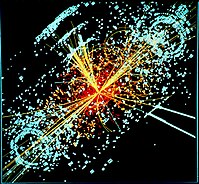
Photo from wikipedia
Background: Unexplained variations of the decay rate parameter for weak interaction decays such as β±-decay, electron capture, as well as strong interaction α-decay have been reported. Because these variations have… Click to show full abstract
Background: Unexplained variations of the decay rate parameter for weak interaction decays such as β±-decay, electron capture, as well as strong interaction α-decay have been reported. Because these variations have been presented by a number of groups, at various locations, using various types of detectors, different isotopes, and over extended periods of time, some researchers have interpreted the source of these variations as not from ambient environmental factors such as temperature, pressure, and humidity but via an unexplained fundamental interaction. Purpose: To review the state of decay rate parameter variations experiments and place the reported results into a common comparable context using a temporal cross section. Then to make decay parameter measurements as a function of time at the level of 10−5 in the presences of an antineutrino flux with an on-off cycle time of ∼30 days. This level of precision requires a detailed understanding of both systematic and statistical errors, otherwise, systematic errors in the measurement may mimic the decay events of fundamental interactions. Two weak interaction decays, one via electron capture and the other via β− decay were selected because the final state and the time reverse state each contain a neutrino and anti-neutrino, covering arguments that the anti-neutrino flux may interact differently or not at all in one of the cases. Methods: The experiment searched for variation of the 54 25Mn, e − capture decay rate parameter and 137 55Cs, β − decay rate parameter both to a level of precision of 1 part in ∼ 10 by comparing the difference between the decay rate, in the presence of an antineutrino flux ∼ 3 × 10 ν cm−2 sec−1 and no flux measurements. The experiment was located 6.5 meters from the reactor core of the High Flux Isotope Reactor(HFIR) in Oak Ridge National Laboratory. Results: The γ spectra from both decays were collected and analyzed independently. The measured variation in the decay rate parameters are found to be δλ/λ = (0.034± 1.38)× 10−5 for 54 25Mn and δλ/λ = (0.67± 1.56)× 10−5 for 137 55Cs. These results are consistent with no measurable decay rate parameter variation due to an antineutrino flux, yielding a 68% confidence level upper limit sensitivity for 54 25Mn δλ/λ ≤ 1.31 × 10−5 or σ ≤ 1.29 × 10−25 cm in cross section and for 137 55Cs δλ/λ ≤ 2.23× 10−5 or σ ≤ 5.69× 10−27 cm. Conclusions: The cross-section upper limit obtained in these null or no observable effect measurements are ∼ 10 times more sensitive than past experiments reporting positive results in Mn and Cs.
Journal Title: Physical Review C
Year Published: 2022
Link to full text (if available)
Share on Social Media: Sign Up to like & get
recommendations!